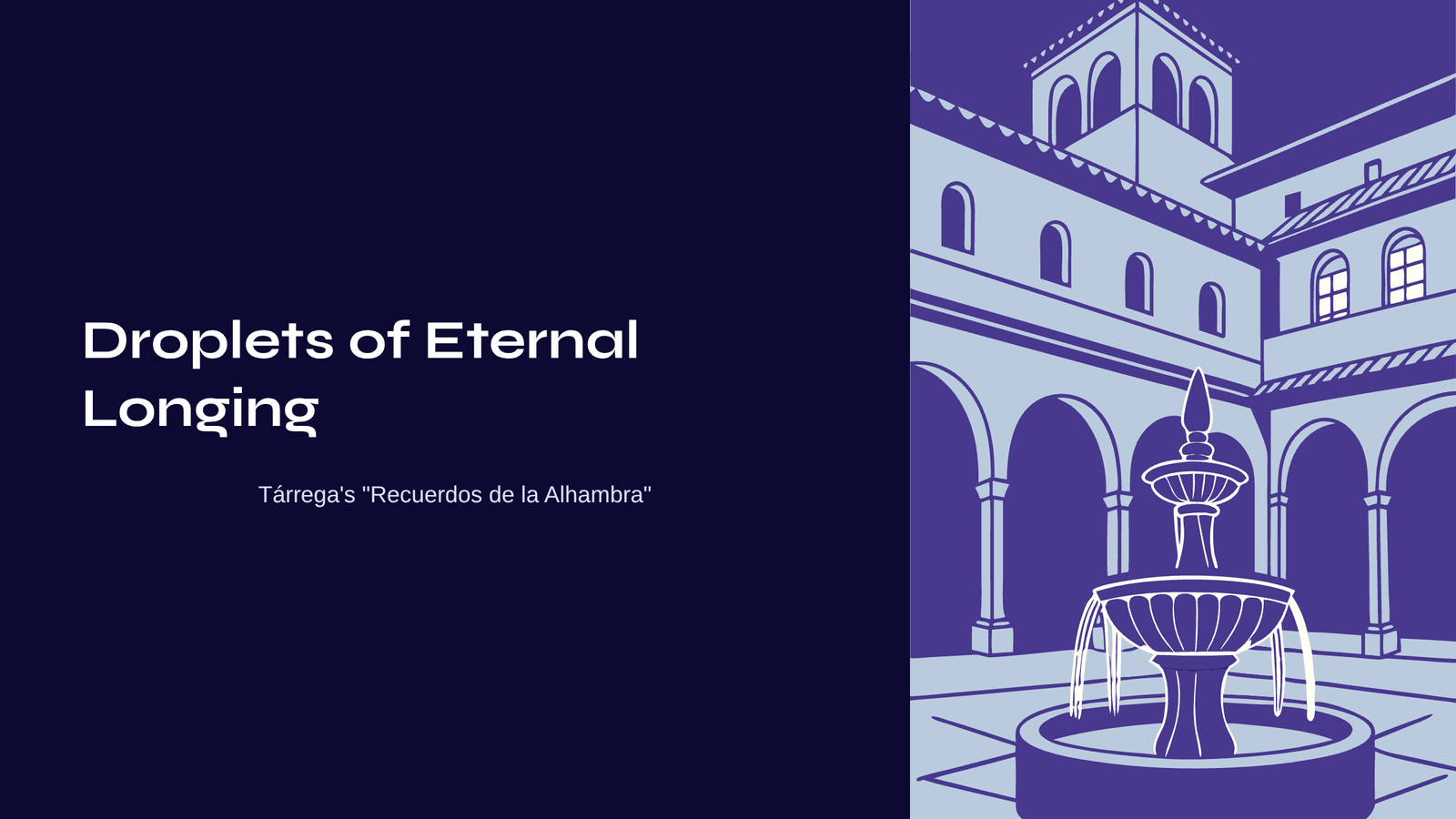Table of Contents
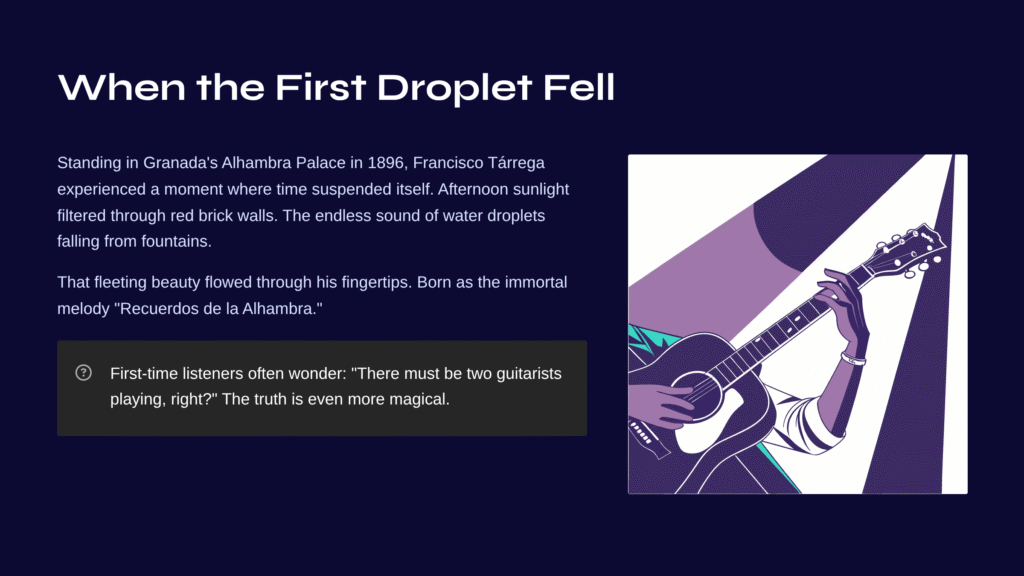
When the First Droplet Fell
Have you ever experienced such a moment? Standing in a place where time seemed to suspend itself, leaving you breathless with beauty? On a day in 1896, Francisco Tárrega encountered exactly that moment in Granada’s Alhambra Palace. Afternoon sunlight filtering through red brick walls, the endless sound of water droplets falling from fountains. That fleeting beauty flowed through his fingertips and was born as the immortal melody we know as “Recuerdos de la Alhambra” (Memories of the Alhambra).
First-time listeners often fall into a delightful confusion. “There must be two guitarists playing, right?” But the truth is even more magical—it’s the miraculous sound created by a single guitarist. What is the secret behind this enchantment?
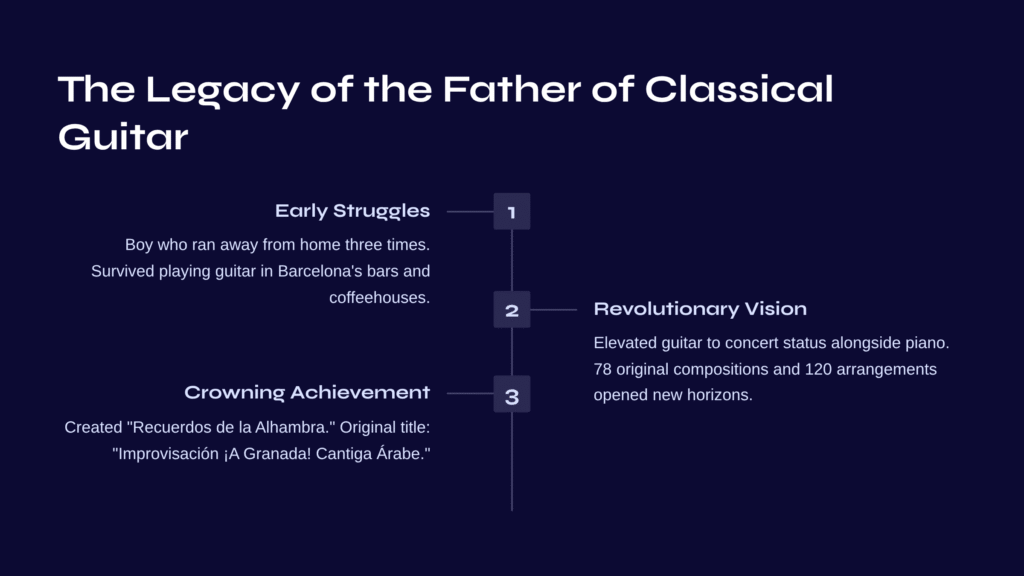
The Legacy of the Father of Classical Guitar
When we speak of Francisco Tárrega (1852-1909), we cannot overlook his tumultuous beginnings. A boy who ran away from home three times, surviving by playing guitar in Barcelona’s bars and coffeehouses. Who could have imagined that this boy would later be called “the Father of Classical Guitar”?
Tárrega’s greatest achievement was elevating the guitar to the same concert status as the piano. At that time, the guitar was mainly considered an instrument for folk music or flamenco. However, through his 78 original compositions and 120 arrangements, he opened new horizons for guitar music.
And at the pinnacle of his achievements stands “Recuerdos de la Alhambra.” The original title was “Improvisación ¡A Granada! Cantiga Árabe” (Improvisation to Granada! Arab Song), which tells us how spontaneous and powerful that moment of inspiration must have been.
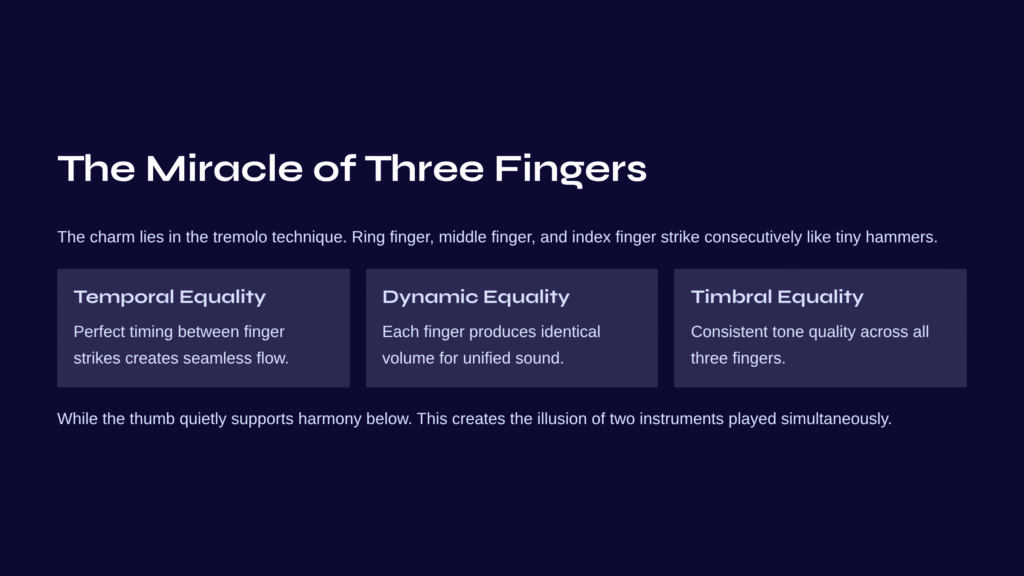
The Miracle of Three Fingers – The Secret of Tremolo
The charm of this piece lies above all in the tremolo technique. While the ring finger, middle finger, and index finger strike the same note consecutively like tiny hammers, the thumb plays a separate accompaniment.
Imagine this: three fingers of the right hand mimicking the sound of falling water droplets, creating an endless melody, while the thumb quietly supports the harmony below. This is the true identity of the magic that creates the illusion of one person playing two instruments simultaneously.
Experts say that perfect tremolo requires three elements to be equal: temporal equality, dynamic equality, and timbral equality. While this sounds simple, it actually requires years of practice to master this advanced technique. That’s why performing this piece perfectly represents both an achievement and a source of pride for any guitarist.
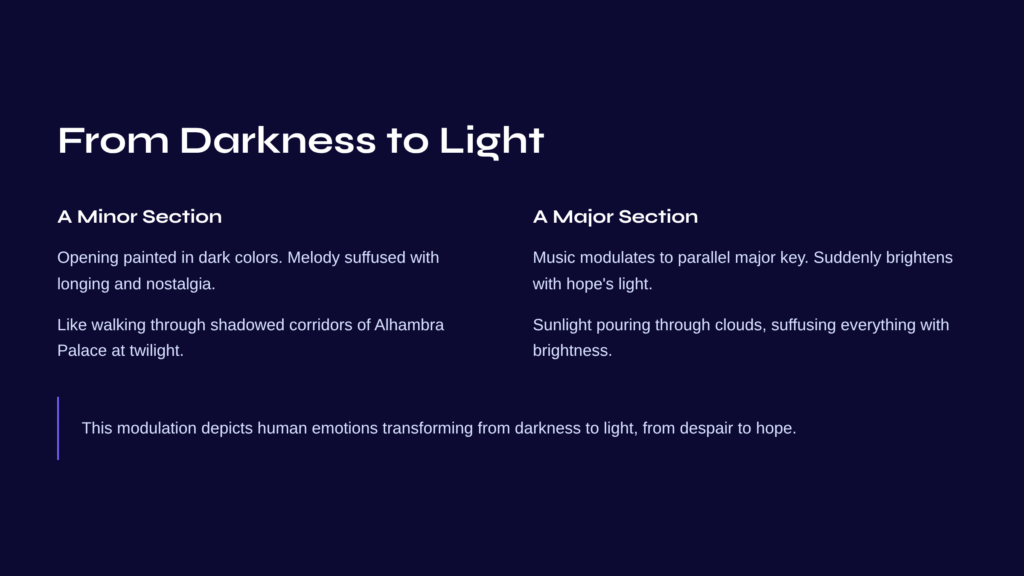
From Darkness to Light, from A Minor to A Major
Looking at the musical structure reveals even more fascination. This piece follows a binary form (A-B) with a coda, where the A section is painted in the dark colors of A minor, and the B section contrasts with the bright light of A major.
Listen to the opening A minor section. The melody is suffused with longing and nostalgia. Can you feel it? Like walking through the shadowed corridors of the Alhambra Palace at twilight? Then, as we transition to the B section, the music modulates to A major—the parallel major key. Suddenly the music brightens, as if sunlight is pouring through the clouds, suffusing everything with the light of hope.
This modulation is not merely a technical device. It’s a musical depiction of how human emotions transform from darkness to light, from despair to hope.
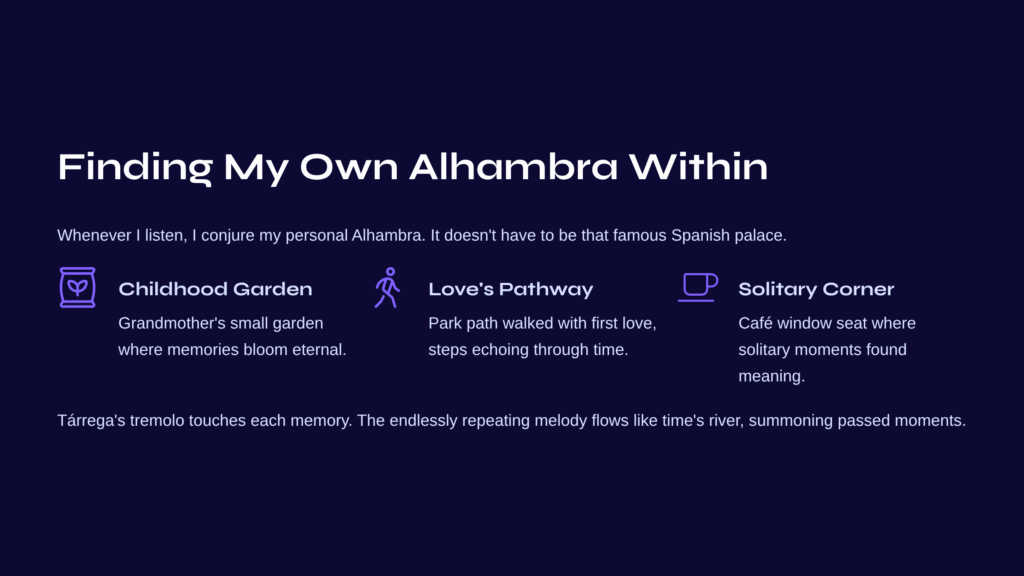
Finding My Own Alhambra Within
Whenever I listen to this piece, I conjure my own personal Alhambra. It doesn’t have to be that famous Spanish palace. You surely have such places too—perhaps your grandmother’s small garden from childhood, the park path where you walked with your first love, or that corner seat by the café window where you spent solitary moments.
Tárrega’s tremolo touches each of these memories one by one. The endlessly repeating melody flows like the river of time, summoning moments that have passed. Perhaps this is why the piece is titled “Recuerdos” (Memories).
The gradually diminishing sound in the coda section feels like memories drifting away. Like grains of sand slipping through our fingers despite our desire to hold them, it reminds us of time’s cruel tendency to make beautiful things fade away faster.
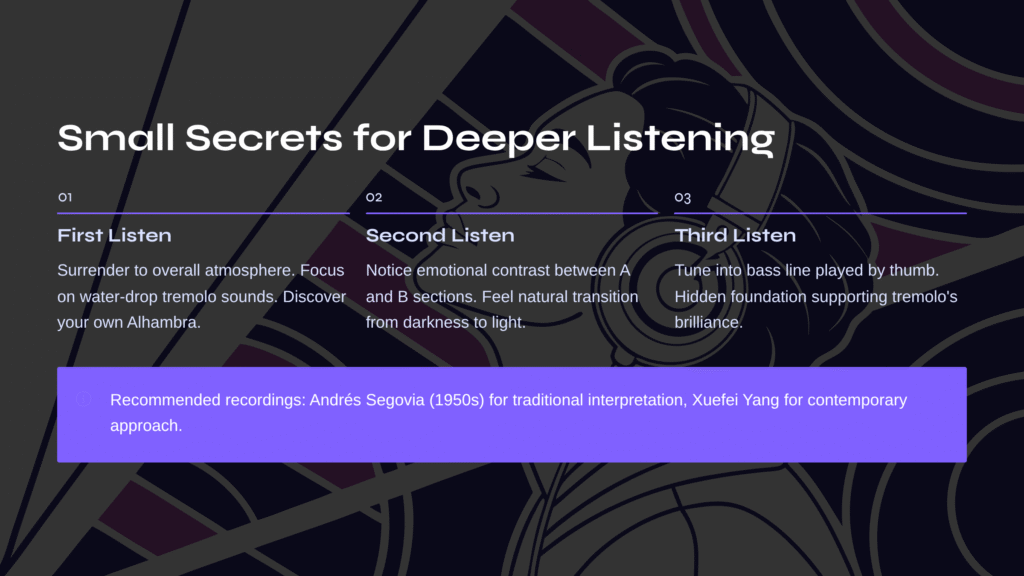
Small Secrets for Deeper Listening
If you wish to appreciate this piece more deeply, let me suggest a few listening approaches.
On your first listen, surrender yourself to the overall atmosphere. Focus on the water-drop sounds created by the tremolo, and observe what scenes arise in your mind. There are no wrong answers—discover your own Alhambra.
On your second listen, pay attention to the emotional contrast between the A and B sections. Feel how naturally the transition from darkness to light occurs, and notice how your own heart changes in that moment.
On your third listen, also tune in to the bass line played by the thumb. Though hidden behind the tremolo’s brilliance, it plays the crucial role of providing the piece’s foundation. Like a supporting actor who quietly upholds the leading performer on stage, it’s unobtrusive but indispensable.
For recordings, I recommend Andrés Segovia’s 1950s recordings for a traditional interpretation, or performances by younger artists like Xuefei Yang for a more contemporary approach.
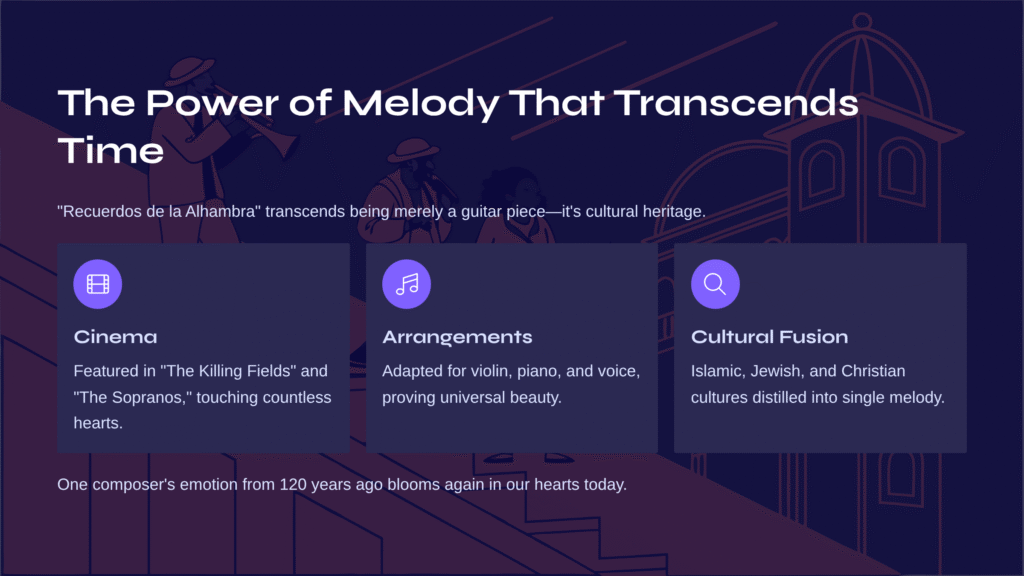
The Power of Melody That Transcends Time
“Recuerdos de la Alhambra” transcends being merely a guitar piece—it’s a cultural heritage. This composition has been featured in films like “The Killing Fields” and TV series like “The Sopranos,” touching even more hearts. The fact that it has been arranged for various instruments including violin, piano, and voice proves its universal beauty.
The fusion of Islamic, Jewish, and Christian cultures left by 700 years of Moorish rule—this complex and beautiful history was distilled into a single melody through Tárrega’s fingertips. Perhaps this is why listening to this piece evokes not just simple nostalgia, but the profound emotion that blossoms where civilizations meet.
If music transcends time, then “Recuerdos de la Alhambra” is perfect proof of this truth. The emotion that one composer felt in a Spanish palace 120 years ago is blooming again in our hearts today.
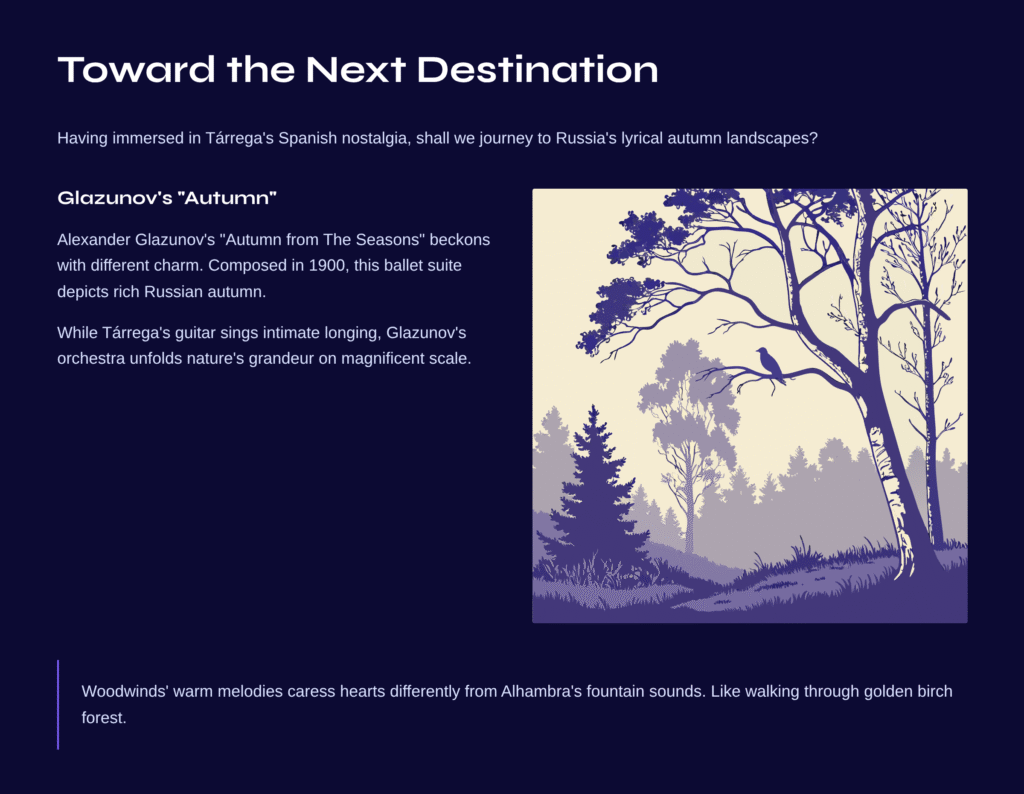
Toward the Next Destination – Glazunov’s “Autumn”
Having fully immersed ourselves in Tárrega’s Spanish nostalgia, shall we now journey to the lyrical autumn landscapes of Russia? Alexander Glazunov’s “Autumn from The Seasons” beckons us with an entirely different charm from Tárrega’s intimate guitar poetry.
Composed in 1900, this ballet suite depicts the rich autumn atmosphere of Russia through the orchestra’s abundant colors. While Tárrega’s guitar sings of personal and intimate longing, Glazunov’s orchestra unfolds nature’s grandeur and seasonal change on a magnificent scale.
Particularly, the warm melodies of the woodwinds in the “October – Autumn Song” section caress our hearts in a completely different way from the fountain sounds of the Alhambra Palace. This music, like walking through a golden birch forest, allows us to savor the mature beauty that the autumn season bestows upon us.
